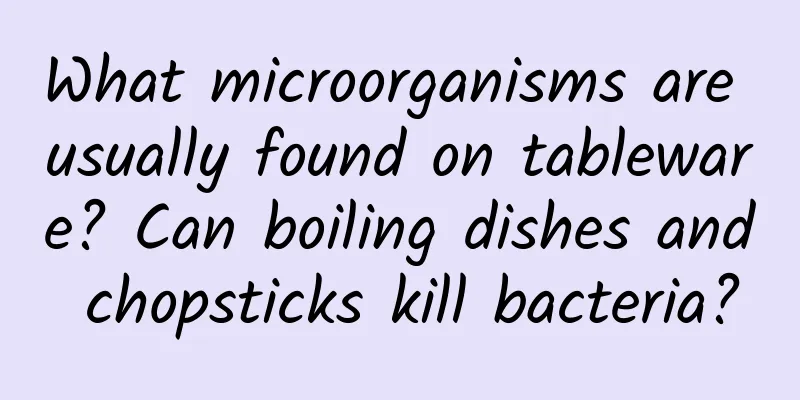What microorganisms are usually found on tableware? Can boiling dishes and chopsticks kill bacteria?

|
So Rinse in boiling water Can it really sterilize? What microorganisms are usually found on tableware? The main ones are bacteria (Helicobacter pylori, Escherichia coli, Salmonella, etc.), viruses (Hepatitis A virus, Hepatitis B virus, Hepatitis C virus, rotavirus, etc.), fungi (molds), and spores. Helicobacter pylori After infection, it is easy to cause gastritis, digestive tract ulcer and other diseases. At a high temperature of 100℃, it can be inactivated in about 10 minutes. The sterilization temperature must be higher than 80℃, otherwise it is easy to resuscitate. Escherichia coli Normal intestinal bacteria will only cause acute diarrhea under special circumstances. They are intolerant to high temperatures and are generally inactivated within 1 minute at 75°C. salmonella It is relatively heat-resistant and most Salmonella can be killed in 15 to 30 minutes at a temperature of 55 to 60 degrees Celsius. Staphylococcus aureus Under certain conditions, enterotoxins can be produced. It has a certain tolerance to high temperatures and can only be completely killed by exposure to temperatures above 80°C for 30 minutes. Spore The dormant form of bacteria is very resistant to high temperature, ultraviolet rays, dryness, radiation, chemicals, etc. Generally speaking, boiling water cannot kill them. Mold Most molds can be killed at 80°C, except for fungal spores (fungi in a dormant state) and toxins produced by some fungi. Therefore, once tableware is moldy, boiling water will not solve the problem. Virus Enteroviruses such as rotavirus can be easily inactivated by heating them in 56°C water for 30 minutes. Hepatitis A, B, and C viruses need to be boiled at 100°C for 1 minute. Can boiling water kill bacteria? At normal temperature and pressure, the boiling point of water is 100°C. Generally speaking, boiling water will kill most common pathogens and bacteria at a temperature of 100°C (212°F). Taking tap water as the water source, boiling water for 1 to 3 minutes can kill most bacteria, which is enough to ensure the safety of drinking water. Unfortunately, the water in the kettle in the restaurant is not necessarily boiled, nor is it necessarily boiled for 1 to 3 minutes. Therefore, if it is difficult to ensure that the boiled water itself does not contain pathogens, it is probably difficult to achieve the desired effect when using it to wash dishes. Dirty tableware ≠ unsterilized In fact, most catering industries use high-temperature boiling + ultraviolet irradiation to disinfect and sterilize. Therefore, when dining out, the bowls and chopsticks that come to our hands have mostly gone through two sterilization processes, and can basically be used directly without worry. Seeing this, you may question: If the catering industry is so well-regulated in sterilization and disinfection, why do we sometimes see food residues on dishes and chopsticks? This is actually a cognitive misunderstanding. The main purpose of tableware cleaning is to remove food residues, dirt, grease and other substances to prevent odor. The main purpose of tableware sterilization is to eliminate or significantly reduce bacteria, viruses and other microorganisms on the surface of tableware, thereby preventing the spread of bacteria. Sometimes we encounter food residue on tableware. It is often because there is a mistake in the cleaning process, not because the sterilization is not done well enough. In fact, the key to sterilization Temperature and time Many people scald tableware for too short a time So the effect is very limited Since boiling water is used to scald dishes and chopsticks Disinfection effect is not ideal So how can we eat cleanly and hygienically? Pre-meal hygiene tips first Always wash your hands before eating (Photo source: Xiangshang Health Science) When unpacking the cutlery You should check carefully first If you still insist on scalding the tableware It is recommended to scald with boiling water for 1 to 3 minutes (Photo source: Xiangshang Health Science) Finally, choose a clean and hygienic restaurant to eat at The shortcut to safety |
>>: Blisters on the mouth are not caused by heat! Be careful of this lifelong latent virus →
Recommend
Does biochemical abortion require uterine curettage?
Biochemical abortion refers to a miscarriage caus...
How to treat endocrine disorders with upper heat and lower cold
Each of us has different physical conditions. Som...
What does the yellow and red color of the lion dance represent? The skills of playing drums in lion dance
People who don't understand lion dance can on...
Can pregnant women drink black rice porridge?
Although black rice porridge does not look good i...
Causes of heavy menstruation after abortion
Many people may have had an abortion, and with to...
What to do if you have a urinary tract infection during pregnancy
Urinary tract infection is more common among wome...
Is it normal to have little vaginal discharge?
Now many female friends know that whether a woman...
Will a girl have her period when she is pregnant?
Menstruation is a woman's "best friend&q...
Elisa: Mobile device sales figures for June 2012: WP and Android each account for 33% of the market share
Elisa, the largest mobile operator in Finland, ha...
What to do if you see blood in late pregnancy
Many women will be more careful to protect their ...
World Kidney Day | "Silent Thief" - Dent disease that "steals" kidney function
If your child has unexplained foamy urine, recurr...
How to effectively enlarge breasts after weaning?
Many postpartum mothers find that their breasts s...
How should women take care of themselves when they enter menopause?
After entering menopause, women not only become i...
Causes of abdominal pain during menstruation
Menstruation is a physiological phenomenon unique...
What to do if pregnant women have difficulty breathing
Pregnant women often encounter the situation of d...









